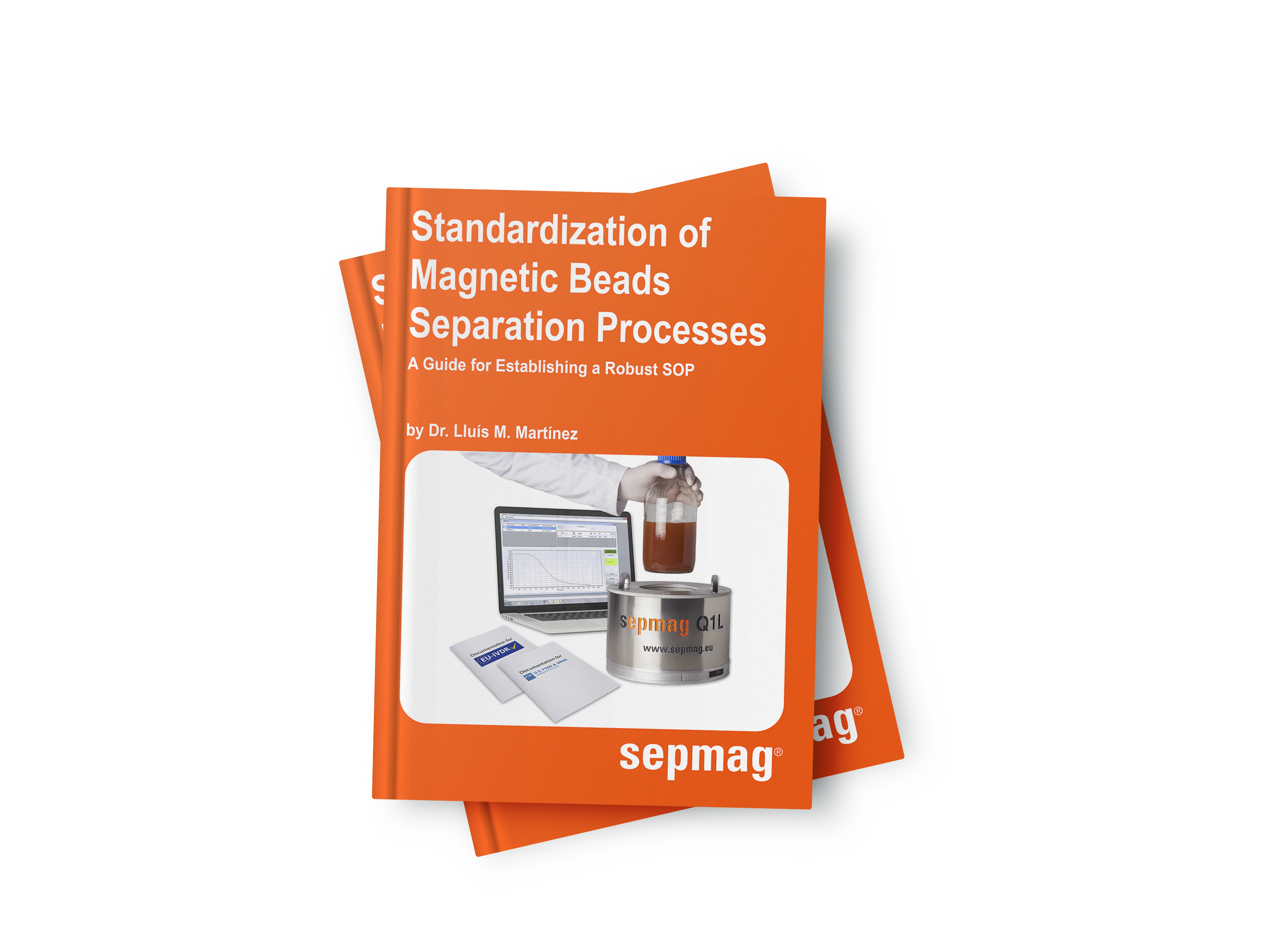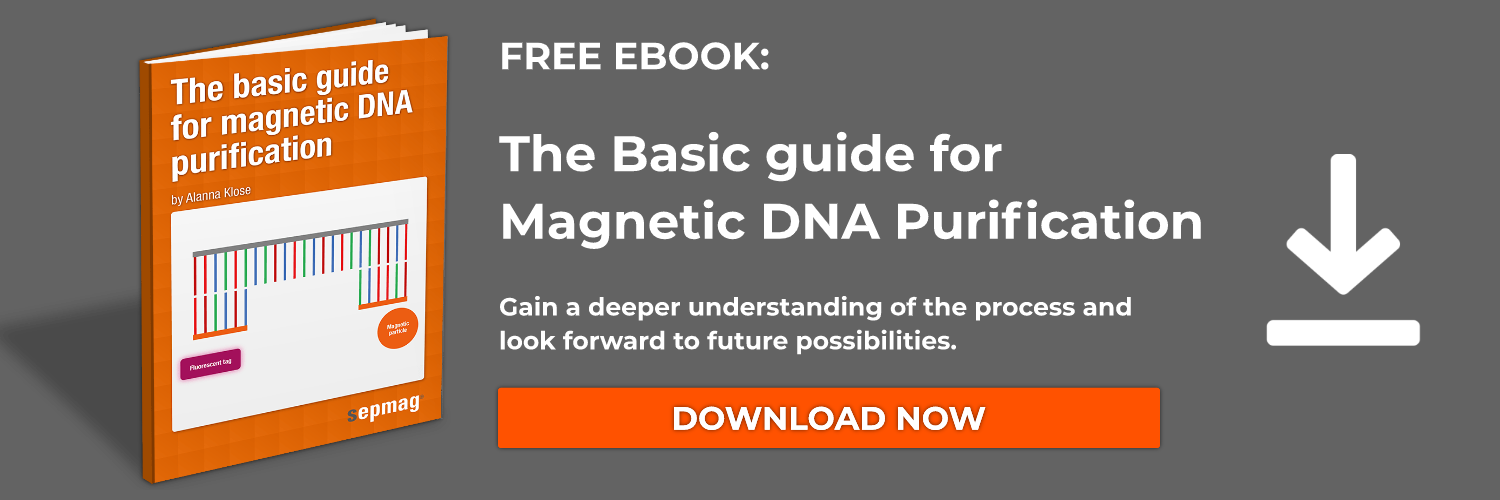The efficient and precise nature of magnetic beads separation has improved our ability to capture and isolate biomolecules. Biomagnetic separation protocols are straightforward too, rendering the fiddly centrifugation and filtration steps required in many processes unnecessary.
However, there are some key differences between magnetic bead technologies and other common biotech protocols that can cause difficulties for new users. Although many steps of common biotech and IVD industry protocols can be directly transferred to magnetic separation processes, it can be easy to overlook the key difference: the magnet itself. Magnets have unique properties and requirements that many users will not have encountered in other protocols.
Overlooking these key differences can lead to issues at any volume, but when scaling-up these problems often become apparent. When scaling up from initial microliter batches, users often find that the process becomes unpredictable and inefficient. The difference is how magnets behave at different scales and understanding how to specify the right magnetic parameters. Inadvertently ignoring these important differences when scaling up can cause scientists a lot of problems.
Specifically, the incorrect adjustment of biomagnetic separation parameters can cause problems with reproducibility, scaling up and additional costs. This can lead to apprehension about the capabilities of biomagnetic separation for manufacturing purposes. So, what are the key parameters we need to consider when running a biomagnetic separation protocol?
Bead Surface Chemistry
The bead surface chemistry you choose should be compatible with the target molecules and the buffer conditions that will be used in the process. The coating and surface chemistry of magnetic beads determines the binding efficiency of the target molecule. Magnetic beads for life science applications come in two formats: core-shell beads and embedded beads.
- Core-shell beads. Core-shell beads are composed of a superparamagnetic core with a polymer or silica surface coating, e.g., a magnetite core with a dextran shell. Others have a polystyrene core and a superparamagnetic particle shell.
- Embedded beads. Embedded beads are made from a monodisperse matrix, such as polystyrene or agarose, which contains many tiny 10nm iron-oxide nanoparticles (also called magnetic pigment).
Adsorption often needs to be reversible to allow magnetic beads to be removed after the target molecule is isolated. For example, when working with nucleic acid suspensions, the magnetic beads could interfere with downstream qPCR applications and need to be removed from the isolate prior to experimentation.
Sample Volume and Concentration
Magnetic bead concentration is a key parameter for biomagnetic separation processes. The concentration of the amount of beads needed is determined by the volume and concentration of the sample. In turn, bead concentration affects important parts of the magnetic separation process. This includes:
- Biologically Active Reagent Concentration. Because the beads are functionalized with antibodies or other biological molecules, the concentration of magnetic beads results in a specific concentration of a biologically active reagent. This is especially important for final IVD kit performance, where the sensitivity of the kit changes substantially with the number of beads in your preparation. As such, controlling the volume of the sample suspension is key. As the production process is scaled up, volume control becomes even more critical.
- Bead-to-bead interactions. In addition, sample volume and concentration also affect bead-to-bead interactions, and therefore the efficiency of the separation process. Magnetic beads interact with nearby beads, creating chains that decrease the time it takes for a cell separation reaction to occur. These bead-to-bead interactions are reliant on magnetic bead concentration: the more beads, the closer any given bead is to its neighbor. The closer the beads, the faster they will form chain structures. As the chains move faster than individual beads, closer beads mean a faster separation process than traditional methods.
- Buffer Viscosity (and Temperature). The magnetic separation speed depends not only on the applied magnetic force, but also on the nature of the suspension . In applying a constant magnetic force (i.e. constant separation speed), we can realize how changes in the viscosity affect the separation time. These changes can be caused by the addition of additives but also by variations of the buffer temperature (water viscosity varies almost a 2%/ºC at room temperature).
- Concentration of Magnetic Beads. It is important to have a good protocol controlling the buffer composition and temperature, the magnetic beads characteristics, and also the magnetic beads concentration. The cooperative nature of the magnetic separation implies that the separation time would also depend on the concentration. In well controlled conditions, theoretical models predict a variation of the separation time proportional to the fourth root of the dilution: increasing the concentration 50% we would have a 10% faster separation reaction as the beads would be closer to their neighbors.
Wash and Elution Buffers
An elution buffer is used to remove any unbound and non-target molecules while leaving the bead-target molecule complex intact. The bead and binding chemistry and target biomolecules should be kept in mind when selecting an elution buffer for your protocol. The elution buffer plays an essential role in immunoprecipitation protocols and assays that require the release of a target antigen from a capture antibody. Elution buffers are also necessary in magnetic separation protocols that use a stationary affinity column, as well as those using mobile solid supports in solution. The conditions used to elute the target molecules from the beads should also be optimized to reduce loss of target molecules. For example, by controlling for temperature the stability of the target molecule-complex is preserved.
Magnetic Strength
To control how strongly the beads are pulled out of solution, users often want to specify that the magnet strength is appropriate for the strength of the magnetic field. The problem is that the strength of the magnetic field is not the proper way to characterize the magnetic separation performance. A perfectly uniform magnetic field would not be efficient for separating magnetic beads, regardless of how intense it would be. If a strong magnet seems to work well it is not because it generates a large magnetic field, but because its magnetic field changes very quickly with the distance to applied magnetic force. However, the resultant magnetic attraction decays very quickly, and cannot be applied beyond very small tubes. More importantly, this variability with the distance force shows that the magnetic separation conditions are not under control. This means we can’t define a value that can be properly incorporated to our protocols.
In conclusion, while the advantages of precision in biomolecular isolation are evident, the often-overlooked nuances of magnetic properties, especially when scaling up, can lead to unpredictable outcomes. From the significance of bead surface chemistry to the intricate interplay of sample volume, concentration, buffer viscosity, and magnetic strength, each parameter influences the success and reproducibility of the separation process. The present chapter dispels the misconception that magnetic strength alone determines efficiency, emphasizing the dynamic changes in the magnetic field as the key factor. Armed with this knowledge, users can establish robust Standard Operating Procedures (SOPs), ensuring efficiency, reproducibility, and the broader applicability of biomagnetic separation in scientific and industrial contexts.
Schematic representation of the technologies involved in magnetic bead-based processes.

Related news:
- Targeted Magnetic Microsphere Delivery of DNA to Encourage Vascular Endothelial Growth
- Controlling Mesenchymal Stem Cell Growth with Magnets in Lieu of a Scaffold
- Magnetic Particles in Fluorescence Activated Cell Sorting
Published on March 11, 2015 and updated on February 22, 2024.





